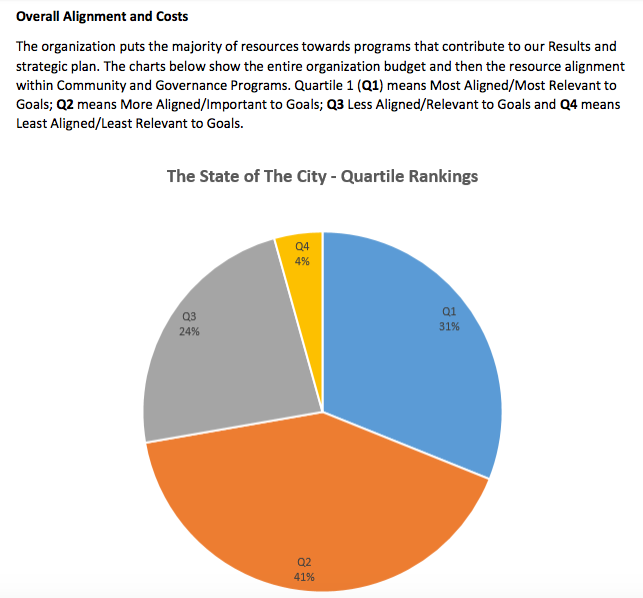School districts have notoriously tight budgets, which makes it absolutely essential to stay focused on the most important programs and services.
Priority-based budgeting is an effective way to help ensure that limited school funds are allocated to the highest priorities first, while also freeing up additional money by eliminating waste and duplicated services.
How Priority-Based Budgeting Works in Schools
Spending and performance go hand in hand when developing a school budget. Priority-based budgeting makes it easier to direct funding to the programs and services that drive student success.
Unlike line item budgets that focus on funding at the departmental level, priority-based budgets take a holistic view. For example, instead of allocating funds to the student services department, a priority-based budget would fund the truancy prevention program and all of its associated personnel and non-personnel resources, regardless of department.
Let’s take a closer look at priority-based budgeting practices throughout the school budgeting process.
Review the Previous Year’s Budget
Most school district budgets are based off of the previous year’s budget, which can leave some programs underfunded and others with a budget surplus.
Without identifying programs with priority-based budgeting, school district leaders have only line items in their budgets to consider—making it difficult to understand how and why some departments have more funds than they need (or not enough).
By running a search with budgeting software, you can find out which programs had money left over at the end of the last budget year and then dig deeper to learn why. For example, explore program data by sorting through department and position name, or flip back and forth between line-item view and program view to fully understand cost allocation.
This information can help you identify areas where money in the new budget can be reallocated to where it’s needed most.
Study Projections To Make Assumptions
Budgeting for schools is not an exact science. School districts must base a portion of their budgets on assumptions. For example, 75 to 80 percent of school budgets go toward employee salaries and benefits, but staffing is based on student enrollment numbers.
The budget team will need to make projections based on factors such as enrollment trends, new housing developments, and other changes in the community that could impact how many students the district will support during the year.
Determine Desired Outcomes
Before you can prioritize programs and services in your budget, you first have to define what results you are trying to achieve.
These outcomes can be broken down into two groups: governance results that serve internal departments, and community results that serve the public. This helps guide and align later spending and prioritization.
Governance results
- Learning organization (internal services)
- Positive culture (internal services)
- Stewardship of resources
- Data-driven decision-making
- Regulatory compliance
Community results
- Learning-centered experience
- Guaranteed and viable curriculum
- Basic conditions for learning
- Learning organization (student facing)
- Positive culture (student facing)
- Differentiated instruction and assessment
Establish priorities
School district priorities are likely to change over time, so it is essential to evaluate them every year. Get input from stakeholders like teachers and administrators to find out which programs and services they think are most important.
But don’t just focus on student development initiatives. Staffing, infrastructure, and capital projects also need to be prioritized in the budget.
It’s also important to consider equity when making budgeting decisions for the district. Spreading resources evenly across all schools might make it impossible to help those with the most need. Through program alignment with the strategic plan, district leaders can prioritize resource allocation depending on where it is most needed.
Decide How You’re Going To Pay For Everything
Now that you know which programs and services the district needs to fund, it’s time to figure out how you’re going to pay for them.
School districts are funded through a variety of local, state and federal sources. The budget team will need to project how much revenue they anticipate from all sources for the budget year, and then compare that number to the cost of funding district initiatives.
Unfortunately, even once you have prioritized thoughtfully, reallocated misappropriated funds, and eliminated defunct programs, there is rarely enough revenue to fully fund every initiative.
This is another benefit of priority-based budgeting. Rather than slashing the budget across the board, the budget team can more effectively consider program opportunities such as efficiencies, service level, and alternative resources—like community volunteer programs.
Present the Budget to the Board
With priorities set, funding projections calculated, and adjustments made, it’s time to send the budget to the school board for approval. To preemptively prepare for the difficult decision-making process the board must face, here are ten questions you’ll need to be able to answer about the proposed budget.
Bringing Priority-Based Budgeting to School Districts
School budgeting is complex and requires the budgeting team to make several assumptions and projections that will affect students, teachers, and other stakeholders.
Following school budgeting best practices and carefully considering priorities and outcomes is essential when creating school district budgets. Appropriate funding will have a significant and lasting impact not only on the students, but on the community at large.
For more information, download The Essential Guide to Priority-Based Budgeting to learn how this model helps align government budgets with the community’s greatest needs.








